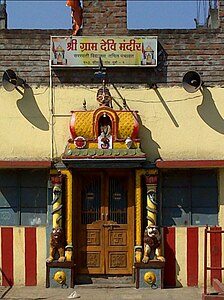Grāmadevatā
Thank you for being part of the Bharatpedia family! 0% transparency: ₹0 raised out of ₹100,000 (0 supporter) |
This article needs additional citations for verification. (March 2021) |
Template:Expand Telugu Template:Expand German

A grāmadevatā (Sanskrit ग्रामदेवता grāmadevatā "village deity", from grāma "village, village settlement" and devatā "deity")[1] is the presiding deity or guardian deity (patron deity), usually a goddess, worshipped in villages in India. Although grāmadevatās are most often goddesses, there are a few notable male exceptions. Dharma-Thakkur is a god of fertility and disease in West Bengal state of India.[2] Another example is found in Kal Bhairav, a fierce form of Lord Shiva is the grāmadevatā in the rural villages of Maharashtra, where he is referred to as Vairavar.[3]
A common pattern, especially in South India, is to have a village goddess (a fertility figure) and a guardian and protector of the village at the village boundary.
Origins[edit]
| Part of a series on |
| Hinduism |
|---|
 |
The earliest appearance of the "Mother Goddess" found in South Asia is in Mehrgarh in the form of female terracotta figurines dating to the 4th millennium BCE. These figurines are believed to represent the "Mother Goddess." Similar female figurines are found in 3rd-2nd millennium figures from Harappan civilization sites, including a woman with a plant emerging from her womb and a woman in a tree (believed to be a goddess) being worshipped by another woman, with seven figures below. Due to their association with agriculture, the idea of the earth spirit of bhumi is still a common association with villages today just as it was in Harappan times. Evidence of continued veneration of a female village deity comes from a terracotta fragment Chandraketugarh from what is now eastern West Bengal dating to the 1st century BCE. The plaque shows a figure holding a parasol, evidently a goddess, being worshipped with earthen pots, fruits, flowers and other offerings similar to those given to modern-day village goddesses. Another group of common iconography related to gramadevatas are the sapta matrika, the "seven mothers." The first mention of these goddesses occurs in the later layers of the Mahabharata dating to the 1st century CE, and their lack of mention in the Vedas indicates a non-Vedic origin for these goddesses.[4] In addition to the fertility goddesses, the various disease goddesses include deities described with unappealing physical characteristics like Mariamman and Mata. These goddesses could be represented in the Harappan period by a goddess with weapons in her hair. Similarly, goddesses absorbed into Puranic Hinduism, like Durga, appear around the 1st century BCE-1st century CE.[4]
Examples[edit]
- Kasba Ganapati is the gramadevata of the city of Pune.
- Brahmnath is the gramadevata of the village Beed Khurd.
- Mumba Devi is the patron deity of Mumbai
- Nookalamma is the gramadevata of Anakapalle city
- Dharmathakur is the gramdevata in many villages in the Rarh region of West Bengal
- Siparia Mai is the gramdevi of Siparia, Trinidad and Tobago
- Village deities of Sri Lankan Tamils
- Village deities of South India
- Jathera or Dhok in Haryana, Punjab, western Uttar Pradesh and Rajasthan
Images[edit]
References[edit]
- ↑ Fuller, C. J. (March 1988). "The Hindu Pantheon and the Legitimation of Hierarchy". Man. 23 (1): 22–39. doi:10.2307/2803031. JSTOR 2803031. Retrieved 5 March 2021.
- ↑ "Dharma-Thakur | Indian deity". Encyclopedia Britannica. Retrieved 14 February 2020.
- ↑ Syed Siraj Ul Hassan (1920). The Castes and Tribes of H.E.H. the Nizam's Dominions, Vol. 1. Asian Educational Services. p. 482. ISBN 8120604881.
- ↑ 4.0 4.1 Elgood, Heather (1 September 2004). "Exploring the roots of village Hinduism in South Asia". World Archaeology. 36 (3): 326–342. doi:10.1080/0043824042000282777. ISSN 0043-8243. S2CID 144268377.





